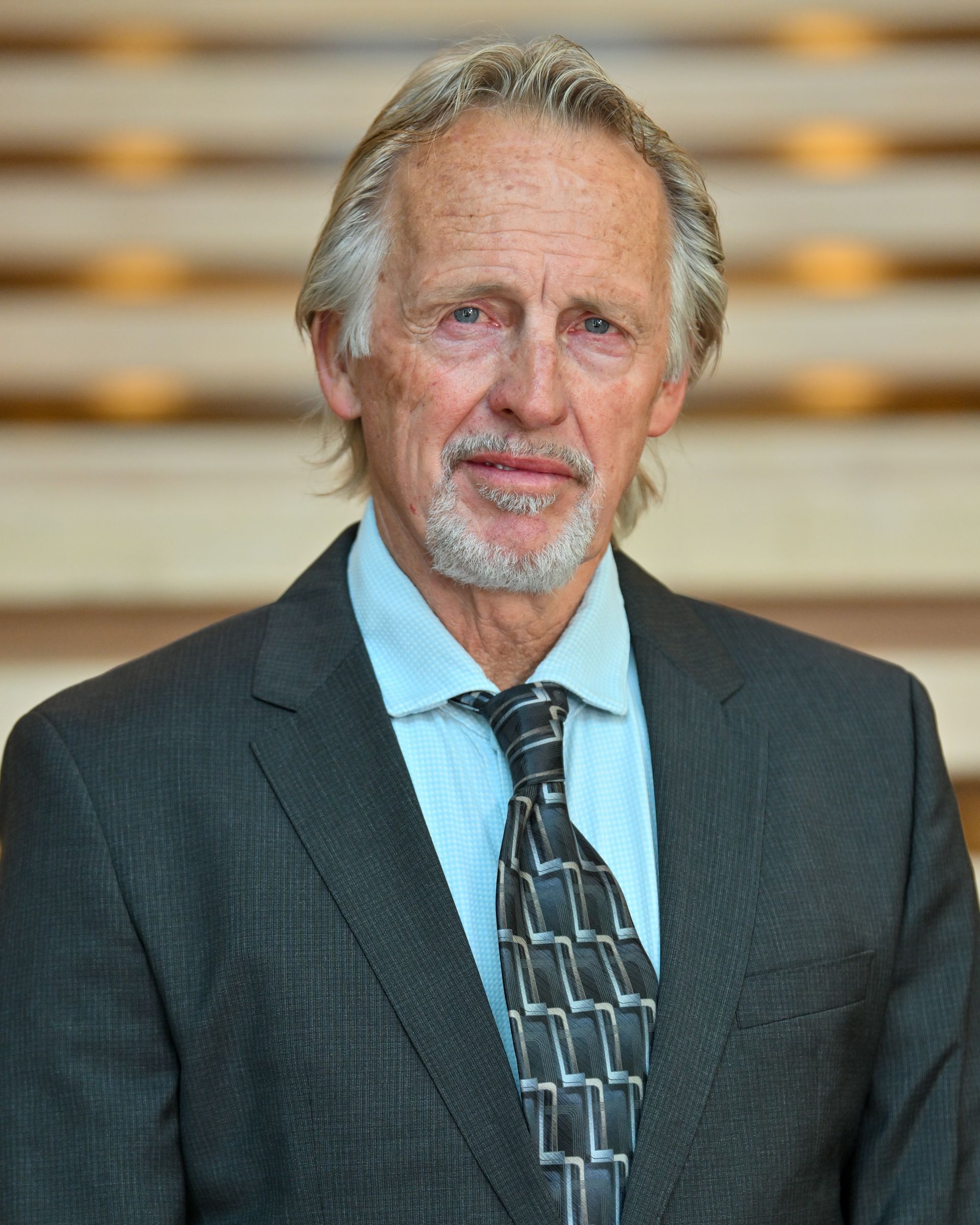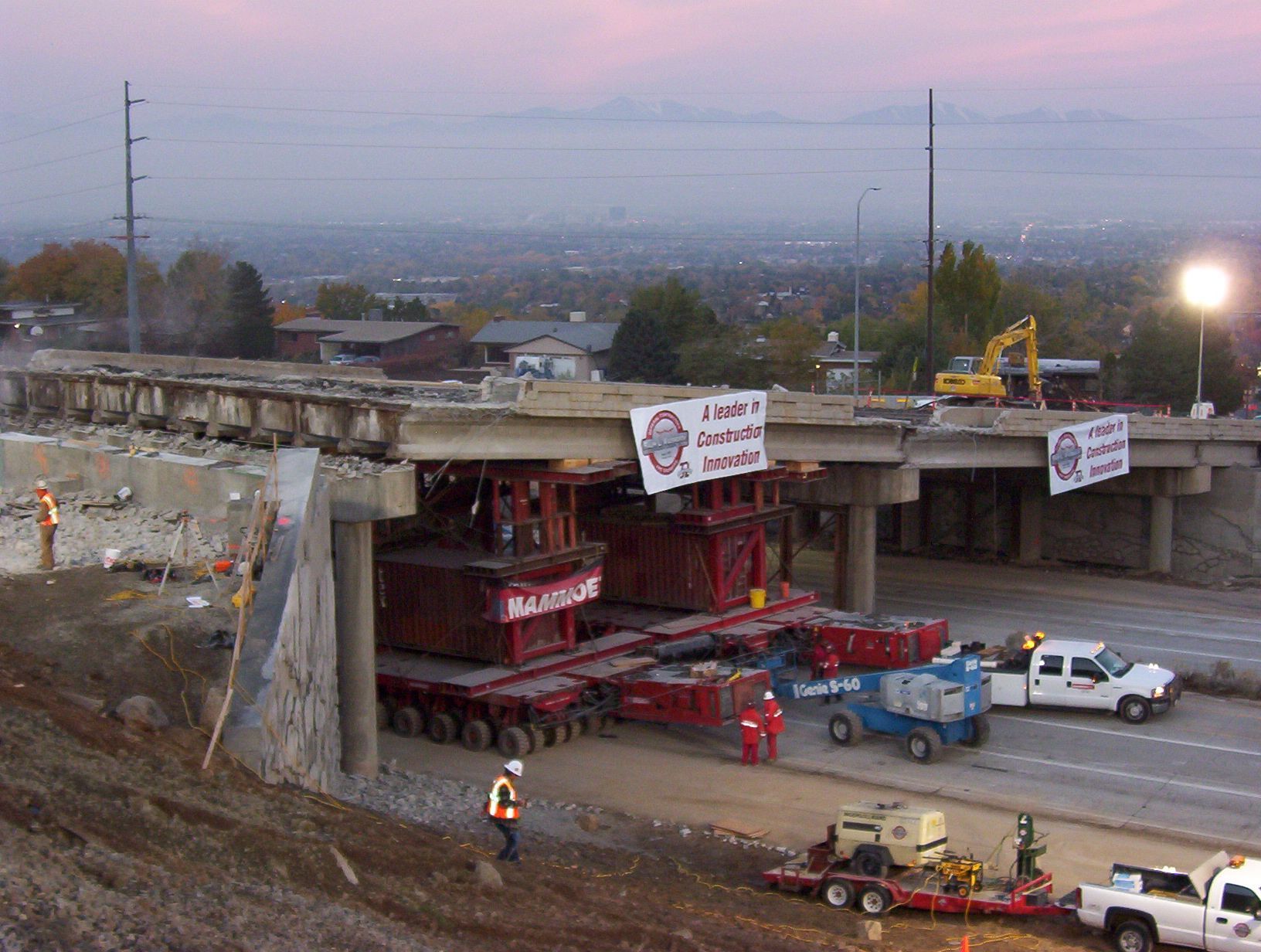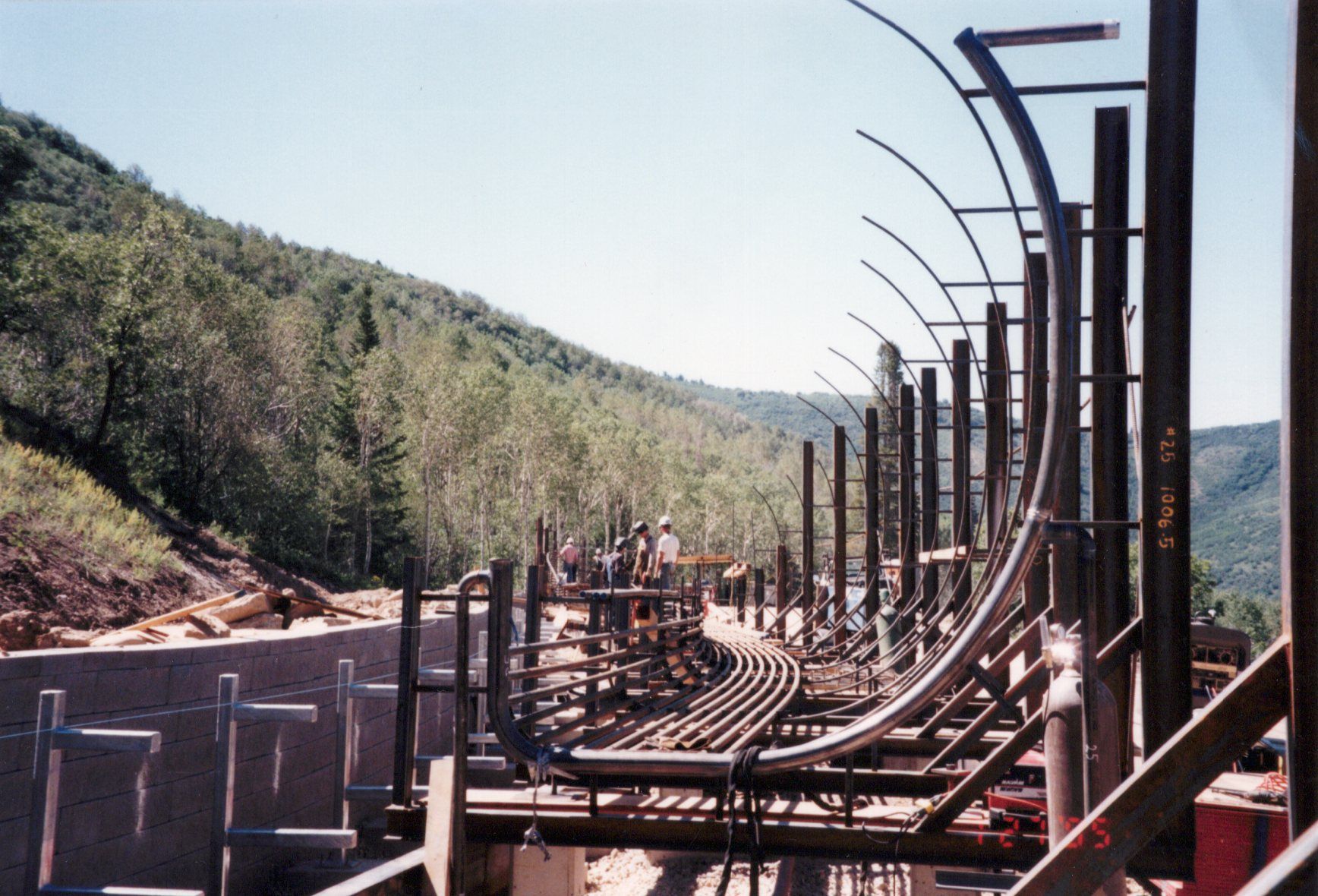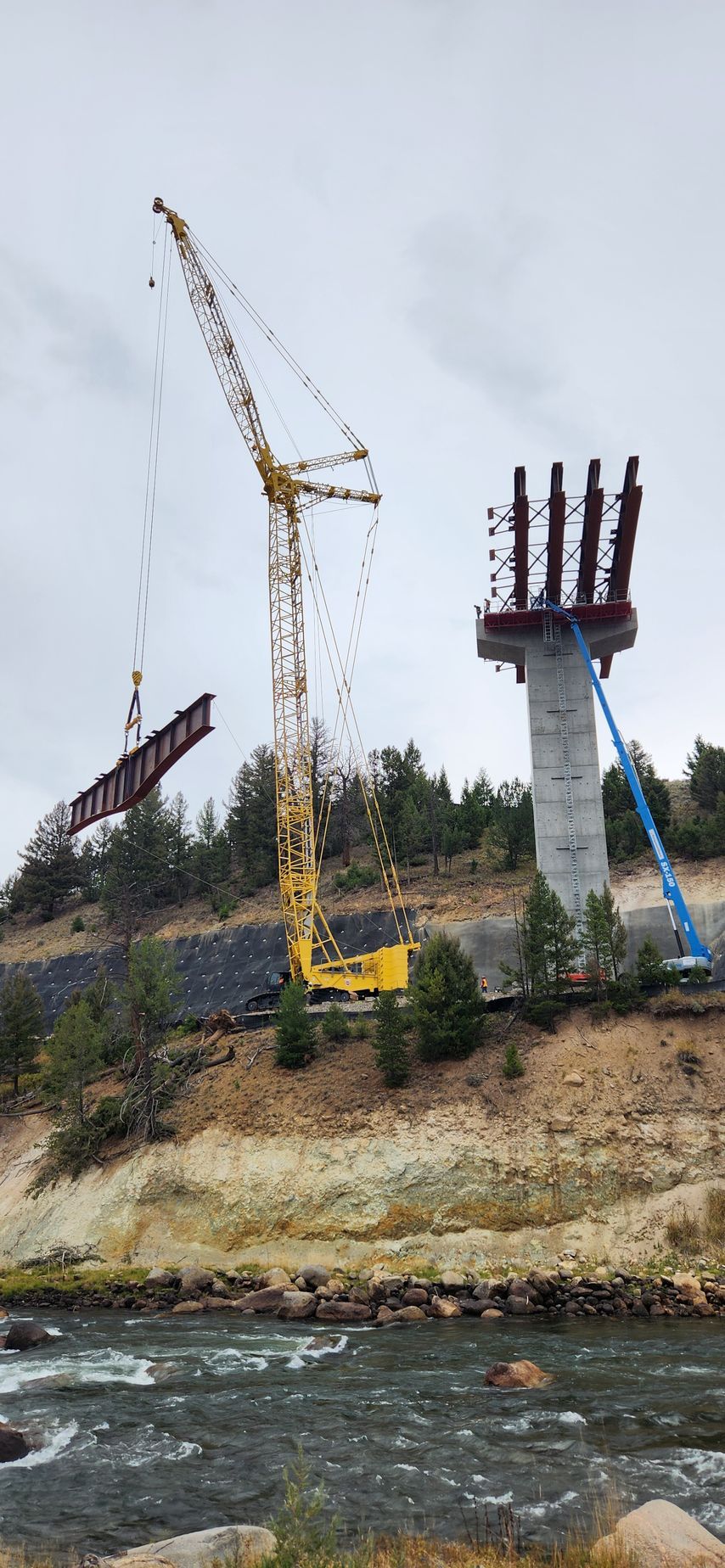Few individuals have positively impacted Utah’s A/E/C industry quite like Ralph L. Wadsworth, whose legacy includes the heavy/highway firm that bears his name, along with three other industry-related firms founded and operated by his posterity. By Brad Fullmer
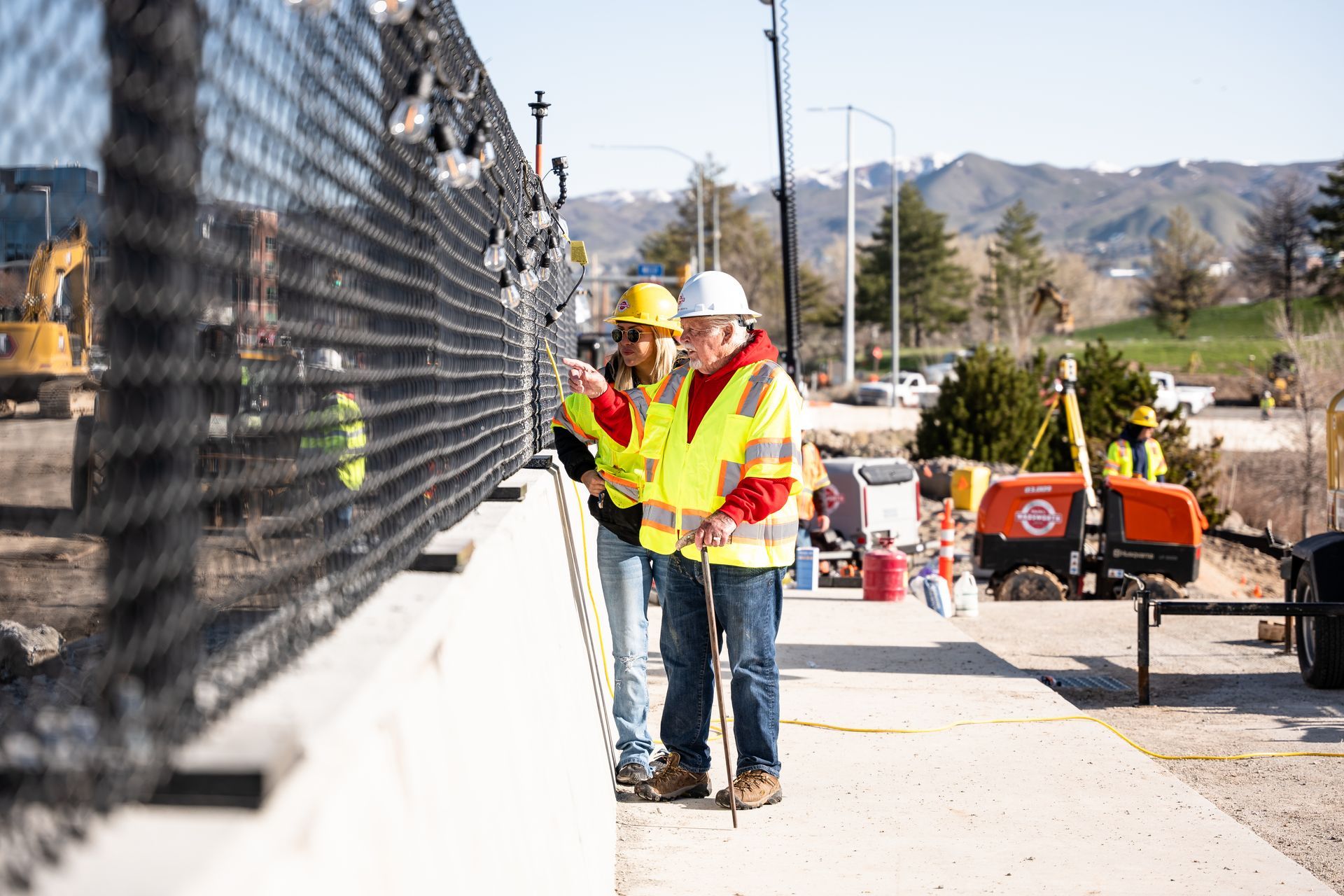
Fifty years after founding his seminal heavy-highway construction company in 1975 in Draper, the legacy of Ralph L. Wadsworth is truly remarkable and one-of-a-kind.
Indeed, few people who have spent their careers in the architecture, engineering, and construction industry can match the accomplishments of the 90-year-old Wadsworth, who mid-career switched from being a talented, highly-respected structural engineer into a general contractor that initially built small park projects before blossoming into a company revered as one of the elite general contractors in the Intermountain West.
Rugged Upbringing Fosters a Can-Do Attitude
Ralph L. Wadsworth didn't have it easy growing up in Eastern Idaho. As the fifth and youngest child of Lawrence and Hilda Wadsworth, Ralph was raised in a hardscrabble environment outside Idaho Falls. He learned the value of hard work at a young age, working for Arrington Construction, in addition to working for his older brother, Golden, who started a construction company in 1950 when Ralph was 16.
Ralph was tough and not afraid of hard work—a fact driven home when he earned a full-ride boxing scholarship to the University of Idaho, where he pursued a degree in structural engineering on the Moscow, Idaho campus.
"You better be in shape and have a hard head," quipped Ralph, recalling his college boxing days. "It gave me an opportunity to get an education and make something of myself."
One memorable experience in the ring came when the University of Idaho boxing team went to Baton Rouge to compete in a tournament held as part of the renowned Sugar Bowl football game. Ralph took second place, maintaining his scholarship and proving his mettle as one tough hombre.
Ralph met his wife, Peggy, during his sophomore year in 1953, and together they built a strong family that eventually included seven strapping sons—the initial core of RLW Construction. After graduating with a Bachelor of Civil and Structural Engineering in 1957, Ralph worked in St. Louis for two years before landing a job in 1960 working for legendary engineer Hoffman Hughes at Salt Lake-based H.C. Hughes Company, one of the top structural engineering firms in Utah. It didn't take long for Ralph to prove himself as a top-flight, talented designer.
"Hoff was the top structural engineer at that time [in Utah]—he worked for most of the big architects," Ralph recalled. "We designed churches, office buildings, and other big commercial projects. He had me design the first lift slab in Utah for BYU. After the five-story building had been designed and was out for bid, somebody from BYU came to our office and asked Hoffman if he knew what I was doing. Hoff said, 'You'll have to take his word—he knows what he's doing.’"
Ralph's confidence soared, and he was later tasked with helping design the Washington D.C. Temple for The Church of Jesus Christ Latter-day Saints, a landmark building for the Utah-headquartered faith, which was completed in 1968.
In 1970, Ralph founded Ralph L. Wadsworth Engineering, figuring it was time to spread his wings.
Within that first year, it quickly became obvious to Ralph that, while being an engineer was indeed a fine career, the real money was in construction. He'd visit job sites, see the kind of work being done on projects he designed, and figured he could do a better job than what the contractors he saw were doing. He had the engineering skills, the moxie to run his own show, and, by the time 1975 rolled around, he had four sons old enough to work for him.
The clincher came when his brother Golden moved to Salt Lake and helped Ralph win a small $130,000 job replacing tile at the Veterans Affairs (VA) Hospital in Salt Lake. Ralph hired his friend to do the tile work, supervised the job, and walked away with a tidy profit.
"I made $34,000," Ralph remarked. "I had been designing some pretty nice buildings and not making that kind of money—it was an eye-opener. So, I went into construction full-time, mostly doing parks and small jobs working for the city and state, before moving onto bridges."
A Hallmark Attention to Detail
When Ralph L. Wadsworth Construction officially began in 1975, Guy was 21, Cal was 17, Con was 15, and Tod was 14. Kip joined the crew two years later, followed eventually by Ty and Nic. Ralph gave his sons plenty of opportunities to learn the various field trades, including carpentry, concrete forming and placement, and everything in between. And he held his sons accountable for the work they did, expecting nothing short of perfection—no matter how difficult the job was, or how inclement the weather.
“He had all these boys and had moved from Salt Lake City to Draper in 1966, buying a three-acre plot. He wanted to teach his boys how to work and be in the country. In hindsight, it was a bold measure to move that far out here," said Tod, currently an Executive Vice President who, along with Con, has been working at RLW since its inception. “We were constantly remodeling the house as kids—we learned demolition, plumbing, electrical, carpentry, sheetrock, and the most fun of all, hand shoveling. He always believed in hard work, doing things yourself, and seeing what you can accomplish."
"We built most of the city parks in Salt Lake County for a decade," Con said. "He wanted things done right. If you can walk the talk, you'll have success."
Ralph was very demanding on jobsites when the situation required it, a no-nonsense man renowned for his attention to detail and reputation for prolific on-site upbraiding. If you weren't doing the job 100% correctly, he wasn't afraid to unleash his displeasure construction crews—his sons included. “He was not afraid to humiliate you and your crew,” said Con, who mentioned Ralph’s motto: anything worth doing once is worth doing right. “If he thought you were doing a bad job, he would not spare any of that with anybody. On the other hand, if you did a good job, he'd compliment you and tell you that you did a good job."
Tod said Ralph's engineering prowess, understanding of materials, and ability to maximize quality offered numerous in-house advantages to RLW's team when it came to bidding jobs.
"What made dad admired and respected was his ability to work hard and honor what he said we were going to do," said Tod. "His engineering background taught him about concrete and rebar; he knew the ingredients to success in concrete and formwork.”
"Dad would visit jobs quite often and inspect your work. If it wasn't up to par, he'd let you know it," added Kip. "But he would also sit down with us and help us figure out how to tackle the problem. He was innovative in figuring out better and faster ways to solve problems."
The I-80/1300 East Bridge Slide is the latest example of RLW’s unmatched success in executing Accelerated Bridge Construction (ABC) projects for UDOT, including the move of this 5-million-pound superstructure. RLW utilized self-propelled modular transports (SPMTs)—a Utah first—in 2008 on the replacement of the I-215/4500 South bridge.
Progression into Heavy/Highway Market; Bridge Expertise Quickly Grows
After seven-plus years of building parks and other smaller commercial projects, the company started ramping up its competitive juices in the early-80s and made its way into the heavy/highway arena, including work on box culverts and bridges for the Utah Department of Transportation (UDOT).
The I-215 Belt Route was being built throughout Salt Lake County at that time, and more work was made available to local contractors. Kip recalls being "the small kid on the block competing with the big boys. We wanted to prove that we knew what we were doing."
RLW Construction landed one of its largest contracts in 1983 to build two bridges for the B-line D-ramp on I-215 at 900 East, and it was off to the races in the transportation market.
"We soon learned all aspects of the business," said Kip. "You couldn't pull the wool over our eyes. All the boys were starting to learn everything about the business. Our vast field experience also gave us an advantage in estimating. A lot of estimators haven't worked in the field. An estimator who came up through the field was invaluable, especially back then when you didn't have software programs that could break it out by production rates and man-hours.”
RLW Construction chased heavy/highway work in both the Utah and Arizona markets throughout the 80s, achieving solid success in both states. During that period, Guy essentially served as Ralph's right-hand man in the office, with Kip also assisting with estimating and project management. Meanwhile Con, Tod, Ty, and Nic worked in the field, initially as laborers before moving into foreman and superintendent roles.
One of the company's standout projects during the decade was the Eagle Canyon Bridge in Emery County, a project that tested the firm’s mettle from top to bottom, particularly Con, who served as Superintendent in 1985-1986 on the ambitious, high-risk job.
"It was one of the first steel arch bridges in Utah; we teamed with Olsen Beal for the steel erection," said Con. "It was a difficult job, to say the least."
Another important project for the firm during the 80s was a bridge replacement in Glacier National Park in Montana, a job Ralph said ranks as "one of the most difficult we ever built, with three piers that were six-feet by 20-feet and 150-feet tall and holding up a 1,000-foot-long bridge.
By the end of the 80s, the company had become experienced and trusted enough doing high-quality concrete work that it landed the complete structural concrete package for the Delta Center, a job that ran from 1989 - 1990. At the time, it was one of the most significant projects in Utah's history as it marked the new home of the wildly popular Utah Jazz.
The concrete scope on the Delta Center was supremely challenging and pushed crews to the edge of their expertise and determination.
"It was fast-paced, with huge sheer walls, big cranes, big form work—it challenged us every day," Tod recalled. "Dad designed the forms perfectly, with chamfer edges, relief of ties. He was fanatic about inspecting the forms, making sure they were clean, the chamfer was perfect, the Bondo was perfect—he was very peculiar about it. In watching him on that job, I realized he was preaching duality. He's out there disciplining everyone, making sure work got done right."
Con and Tod played key roles on the Delta Center project. Con was a nightshift superintendent building walls, while Tod was a laborer trying to do a little bit of everything, realizing the value of having effective “supers” on larger jobs—guys that managed the work as opposed to physically building the project.
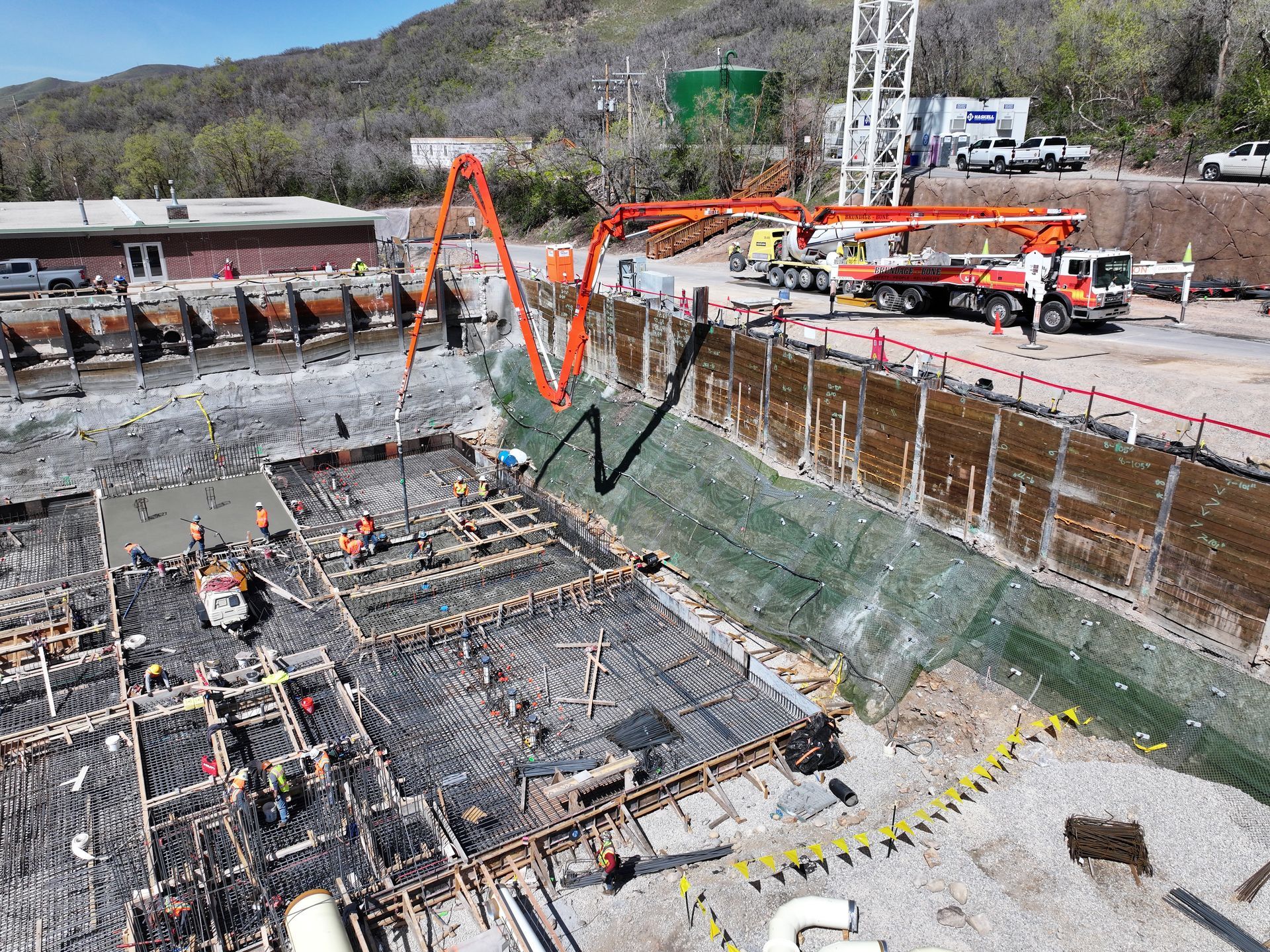
Within the past decade, RLW Construction has expanded into the water resources market, showcasing its expertise on technical water and wastewater treatment plant projects like the City Creek WTP.
1990s: Fierce Brotherly Competition Drives Progress, Expertise
Shortly after completing the Delta Center concrete work, Guy decided to strike out on his own, with a firm resolve that he could also compete in the heavy/highway market as Wadsworth Brothers Construction, while benefiting exclusively on his own merits, rather than sharing the pot with a handful of other siblings.
The new dynamic immediately thrust additional responsibilities on Ralph and the remaining five sons, with Con and Tod assuming project management/field supervision, Kip taking over the estimating, finance, and business development role, and Ty and Nic upping their field duties, as well.
Throughout the 90s, the two firms regularly went head-to-head on numerous projects for UDOT and other municipalities. Competition made both firms sharper, while also directly benefitting the taxpayers who ultimately fund public transportation work.
"That was another level of competitiveness—now you're bidding against your brother," Kip remarked about the sibling rivalry. “When you look back on it, it was a good thing—it made us both more successful. That competition was one of the key elements in helping us rise above and be at the top of our game. We've saved UDOT tens of millions, if not hundreds of millions of dollars by now. It's been great for owners and the public in general."
Diversifying into Real Estate Development a Shrewd Business Decision
By the mid-90s, Ralph was intent on building a new company headquarters closer to the family home in Draper. He also got wind of a future new I-15 interchange at the south end of Salt Lake County, prompting the company to invest in a four-acre plot that became Wadsworth Business Park, the family's first foray into real estate development.
Ralph said he collaborated with an architect friend, Winter Delamar, who had worked as a draftsman at RLW Construction, on the design of the four-building project.
Kip continued to work full-time at RLW Construction during the first few years of Wadsworth Development Group's existence, before transitioning over permanently in the early 2000s.
"Kip wanted to rent buildings out," said Ralph. "He figured he could do it as well as anyone else. His thought was, ‘We'll make more money than in the construction business and we'll have another company to fall back on.’ Kip is a visionary guy—he's smart as hell, and a hard worker."

RLW’s Geotechnical Division specializes in piling and shoring, including deep pile driving on heavy/highway, civil, and general building projects alike.
Olympic Bobsled/Luge Run Drives Innovation; Company Adds Divisions
By the dawn of the 21st Century, Ralph L. Wadsworth Construction continued its aggressive approach to the construction industry, taking on perhaps the single most challenging project in its history—the Utah Olympic Park Bobsled/Luge Run in Park City in 1999-2000, billed as one of the fastest tracks in the world and a model of innovative design and construction.
"That was a big part of our legacy," said Con. "I worked physically on every aspect of that project. Everything was complex.
For the piping system, we had to build a jib in the shape of the run, and every 20 feet, there was a metal jib. We would follow with soffit forms, and the pipe crew would lay pipe behind it. Every section of track was different in mass, size, height; expansion joints were based on length of pipe. What made it tough was that on some of those [concrete] pours, we had to pour 300 feet of track. From when you started to when you were finished was 24 hours. The grout had to be perfect, as did your scraping. We did shotcrete by hand and then pull the board off. That was the toughest job I ever did physically."
"Pours would last 20 hours—it was so difficult," added Nic, with extreme challenges associated with finishing concrete inverted in some parts. Ultimately, the job stands as a hallmark for RLW Construction, with strong memories for those who built it, and a sense of pride that is unparalleled considering the magnitude and social significance of the 2002 Salt Lake City Winter Olympics.
"One of the [bobsled racers] said it's the smoothest track he'd ever been on," said Nic. "That's hard to do when you've never done something like that before."
One of the firms’ signature projects is the Utah Olympic Bobsled/Luge Run in Park City, which required a Herculean effort from RLW crews, led by Con and Tod, among others. Ralph called it one of the single most difficult jobs his company ever built.
Pioneers of Accelerated Bridge Construction
It's been nearly 17 years since the Utah Department of Transportation (UDOT) made a big splash into Accelerated Bridge Construction (ABC) when crews from Ralph L. Wadsworth Construction methodically removed the old 4500 South I-215 bridge and slid a new four-lane, 172-ft., three million-pound concrete and steel bridge superstructure into place in a single weekend (October 27-28, 2007) utilizing self-propelled modular transporters (SPMTs), a historic first for UDOT.
Championed at the time by Jim McMinimee, former UDOT Director of Project Development, the use of SPMTs—multi-axle, computer-controlled platform vehicles manufactured by Netherlands-based Mammoet—was a major leap of faith for all parties involved, considering the inherent risk on a project of that size.
"When it first came to us [...] we thought it was impossible," said Tod, whose firm moved seven bridge structures into place via SPMTs on the I-80 Reconstruction project, building the legendary "bridge farm" directly northeast of I-80/1300 East. "From the initial concept, we had to figure out how to build something of this magnitude and then move it. The geometry was very complicated."
"There were so many unknowns," Tod added. "We spent a long time educating ourselves and the design team and concluded that it was possible to do. Moving a structure of that magnitude—without damaging it—was a major feat."
Following its success with SPMTs, the firm performed its first “bridge slide” in 2009 on SR-66 over the Weber River in Morgan that utilized a unique dead man pulley hoisting system.
“We’re always looking for innovative ways to push or pull a bridge,” said Tod. “By process of elimination, we came up with simpler methods by pulling the bridge.” Most recently, RLW performed two flawless bridge slides as part of the I-80/I-215 Reconstruction in 2023, including a five-million-pound superstructure on 1300 East that Tod said was slid into place utilizing just two elastomeric bearing pads instead of four, making it easier to control the bridge during the slide.
To date, RLW has moved more than 40 bridges into place via ABC methods.
Bridge building remains RLW’s forte, including this complex replacement of the Yellowstone River Bridge located at Tower Junction (Wyoming). The project calls for the replacement of the 60-year-old bridge with a new, one-quarter mile (1,285-foot) steel girder bridge, along with realigning a mile of the Northeast Entrance Road.
Transitioning to the Next Wave of Leadership; Looking Ahead to the Next 50 Years
In December 2009, Houston-based Sterling Construction acquired 80% of Ralph L. Wadsworth Construction for $64.7 million. The transaction allowed the family to cash out, with Con, Tod, and Kip still serving as top executives and running things the way they always did.
Current company President Brandon Squire is an 18-year veteran of RLW Construction, hand-picked to serve in the company's top executive position in February 2016. Squire spent a decade at the Utah Department of Transportation (UDOT) as a construction engineer and construction manager, and began working directly with the Wadsworth family in 1999. He quickly captured the Wadsworth family’s attention with his straightforward way of doing things and insistence on high-quality work. He met with Con, Ralph, and Kip regarding a project, and then worked with Ty on another project, and realized the sum of their parts was greater as a whole.
"Each one of them were very unique," said Squire. "They all had different skillsets. Kip was obviously the businessman, very savvy, refined, and well-spoken. Con was down to earth, very construction savvy, the builder of the group. Tod was very energetic, and is just an optimistic, very positive individual. Ty was very into the details, very analytic, not as much emotion, but if you listened to him, he brought up valuable points. It was very interesting to see their dynamic together. They were a very powerful team, those four brothers, with complementary skillsets."
Squire said major decisions between the brothers were often heated but never got personal.
"There were definitely times when they had some heated disagreements, but at the end of the day, they would hear each other out and come together and still pull towards a common solution. That's one thing I've valued. As I've built my team to have different personalities and skillsets, my job is to hear out differing opinions and listen to the pros and cons of the different personalities."
Con said Squire's ability to gather information from multiple people before making key decisions is one of the reasons they pursued him when it was time to bring aboard new talent back in 2007, when the company was starting to hit its stride.
"If you don't have good people, you don't have jack," said Con. "We've raised a lot of guys and made key hires over the past 20 years. Brandon is a perfect example of that. We aggressively went after Brandon [Squire], Mike MacArthur, and Scott Gubler. We saw it as an opportunity to get some great people, and these guys are all great workers and very competitive, but not so competitive that they do stupid shit on bid days. You can't run a company like this without great employees."
Con continued, "It's not a one-man show by any means—there are three guys capable of running this company right now. Brandon has the right personality for it, the right temperament. Mike and Scott are more than capable leaders and also not afraid to take on new challenges. To me, it's like the 'Dream Team'—they work hard, they know how to win, they're driven. We have a lot of great practices in place, we have a lot of fun, and we treat our employees well. It's essential for people to feel like they're part of something, that they understand what it's all about."
Squire, along with MacArthur and Gubler, have been eager to expand RLW's services and overall capacity, along with maintaining its geographical footprint throughout the Intermountain West. The firm differentiates itself with its ability to provide top-shelf services and excel in a wide array of building markets, including heavy/highway, transportation, aviation, commercial building, water resources, and railroad. RLW also excels in geotechnical solutions, alternative project delivery methods, mission critical, and design and preconstruction services.
And while the company will always be renowned for its outstanding bridge construction capabilities, its current leaders want existing and prospective clients to know RLW Construction can serve as a "one-stop shop" for a litany of construction needs. The executive team has its sights set on doubling current revenues within the next 10 years and topping the coveted $1 billion mark in annual revenues. It's a bold outlook, but one they're confident in.
“We’ve made strategic decisions to broaden our horizons and get into other markets that provide opportunities for employees to grow,” said MacArthur. “One of our top traits is fearlessness. We’re not afraid to take on most anything.”
"In the 1980s and 1990s, we were known as a bridge contractor," said Squire. "In the 2000s, we took on more work in other areas. Some people still view us as just a bridge contractor, and yes, we're the best at building bridges and utilizing ABC methods. But I view that expertise as just part of our skillset. We're way more than that."
Indeed, with their storied past and strong foundation across so many disciplines, RLW’s future has never looked brighter.



















